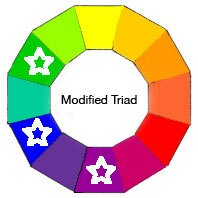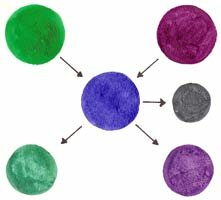Modified Triad Color Scheme

A Modified Triad Color Scheme is another three-color versionof a basic Triad Color Scheme. In this variation you use three colors with one space between each.
Any combination on a Basic Color Wheel which forms a triangle is considered a Triad. This definition allows three possibilities.
- Basic Triad
- Complementary Triad
- Modified Triad, the one we’re discussing here.
Split Complementary color schemes also use three hues and are technically a Triad. But they’re in a category by themselves because of the way they interact.
In any Triad combination, as the triangle gets larger with more spaces between each color, the palettes will create more vibrant paint mixtures.
A Modified Triad is the smallest triangle we can form on the Basic Color Wheel with the fewest spaces. There’s only one space between each Hue so the colors are quite similar. Move the triangle around the Basic Color Wheel and choose any three colors. Notice how they all contain aclose family of Hues and are nearly Analogous.
Even though they are closely related, the single space between each color in a Modified Triad gives them a little breathing room. There’s a bit more contrast with the mixed paint colors because one of the pairs has three spaces between them. This easily creates a harmonious Color Schemewith lovely neutrals.
Example of a Modified Triad Color Scheme

In this example Green + Blue + Violet have been selected.
Blue is the Mother Color in this case.
Because Blue is halfway between Green and Violet we get fairly subtle changes when you add a tiny drop of the Blue Hue to each.
Blue + Green = Blue / Green
Blue + Violet = Blue / Violet
Blue + Green + Violet = Neutral Grey
The Neutral Gray to the right of the Blue is a combination of the three colors and will always be a neutral that never clashes.
Simply add a tiny drop of one of the other two hues automatically begins to harmonize and shift the brightness. That’s because Green contains some Yellow and Violet contains some Red. Each one is influenced by the hidden Complementary Colors.
Remember, you can extend your range of paint colors even further by adding different amounts of White, Black or Gray to tint, shade or tone down the colors even more.
You also have the option of choosing either of the other two as your Mother Color. This would give you entirely different paint mixtures.
Painting Tips for a Modified Triad Color Scheme
- Never use any color straight from the tube. It will always be too garish.
- Use neutralized colors for about 60% of the area. Then use mid-intensity color for about 30% and bright accents for about 10%.
- Use the Mother Color method to harmonize by adding a TINY drop of it to every mixture.
- Use various intensities of that dominant color, by adding different proportions of the two other hues. Then vary the values by adding white to lighten or black to darken andgrey to tone down.
- For contrasting accents, choose one or both of the non-dominant color. Make sure it has a tiny bit of the dominant Mother Color mixed in to soften it a touch. Otherwise these accents will jump out to the eye a bit too much.
- Experiment with various balance of mixtures on a piece of paper or in your sketchbooks before you start working on a project. It will give you a better feel of the full range of colors you can achieve.
Check out these Color Schemes
Adjacent Tetrad
Analogous
Analogous Complementary
Multi-Color

